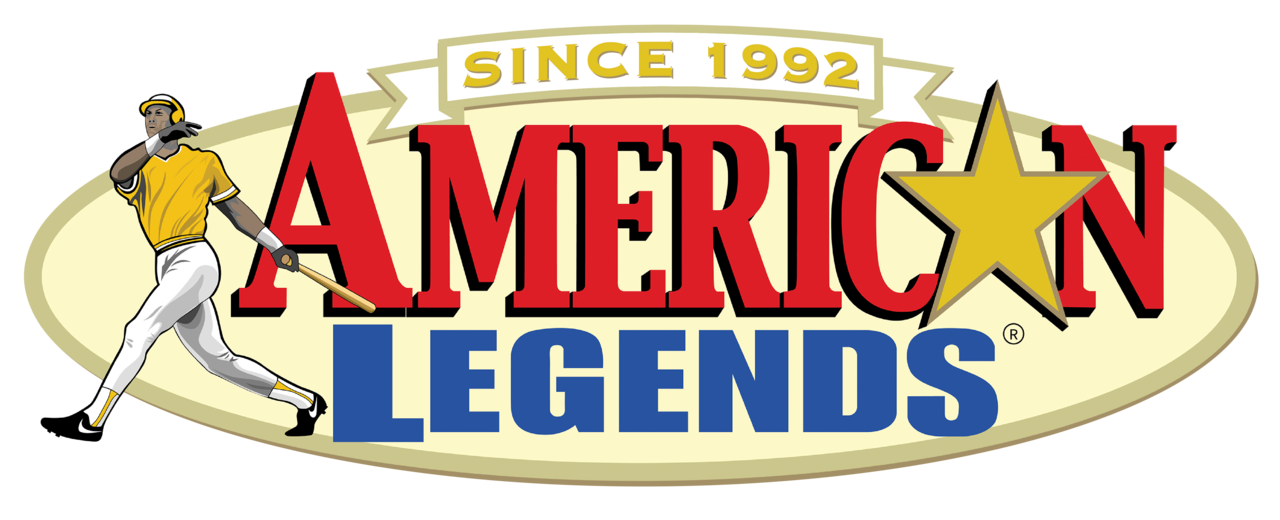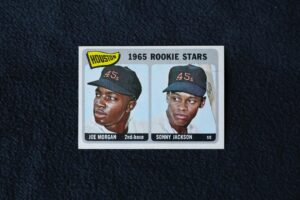Lou Gehrig Baseball Cards
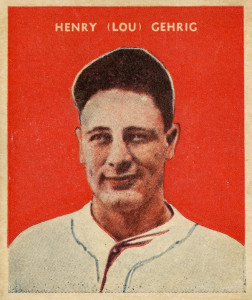
Broad shoulders, strong hands and an immense threshold for pain. How else does one explain the 17 fractures that doctors found on Lou’s hands from X-rays taken late in his career?
It was this approach that earned Gehrig the nickname “The Iron Horse” along with his 2,130 consecutive games played streak.
Gehrig wasn’t just a hard working player, he was also one of the most gifted hitters in the history of the sport.
Gehrig was baseball’s premier RBI man, leading the league five times. He drove in almost 2,000 runs in his career, including an amazing seven 150+ RBI seasons and three 170+ RBI seasons.
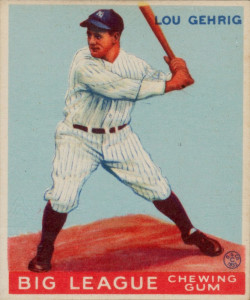
Playing in the large shadow of Babe Ruth, Gehrig carved out a sensational career, winning six World Series for the Yankees compared to the four that Ruth won in the Bronx. Gehrig’s World Series numbers were spectacular; 10 HRs, 35 RBIs, .361 BA and a .483 OBP in 34 games.
Despite his incredible appeal, Gehrig was portrayed on just a little over 60 cards during his playing career, a relatively small number for a player of his stature.
Gehrig first appeared on trading cards in 1925 when has was featured in the W590 Strip Cards and the W461-4 Exhibits Set 4.
Although he appears on a number of Exhibit card, Strip cards (W-cards) and Candy & Caramel cards (E-cards) in the early portion of his career, his first mainstream issues aren’t until 1932 in the U.S. Caramel set.
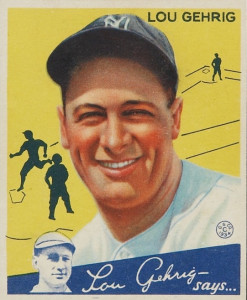
With the Goudey company entering the baseball card business, Gehrig became a fixture on some of the most popular cards of the decade.
In the 1933 Goudey Baseball set, Gehrig has two cards, #56 and #92 both with the same pose. Goudey selected Gehrig as one of their spokespersons in 1934 and 84 of the cards in the series contain the tag line “Lou Gehrig Says,” along with a small photo of the Iron Horse. Gehrig is also highlighted on cards #37 and #61, this time with different poses.
If 1934 was Gehrig’s greatest season on cardboard, it may also have been his best on the diamond. Gehrig captured the Triple Crown while leading the league with 49 HRs, 166 RBIs and a .366 BA.
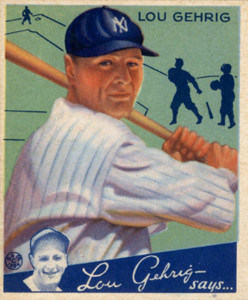
Years after his retirement (and death), his 1951 Topps Connie Mack’s All-Stars card remains extremely desirable and tough to find.
Sadly, no discussion of Gehrig is complete without mentioning his losing battle with Amyotrophic Lateral Sclerosis, also known now as Lou Gehrig’s Disease.
During the 1938 season Gehrig started to exhibit symptoms of the disease and his average dipped under .300 for the first time since his rookie season.
After a poor start in 1939, Gehrig visited the Mayo Clinic in June and was diagnosed with ALS. Just two weeks later, on July 4th, Gehrig retired and was honored in front of a packed, emotional Yankee Stadium.
Gehrig’s memorable speech (paraphrased here) “Today I consider myself the luckiest man on the face of the earth. I might have been given a bad break, but I’ve got an awful lot to live for.” is the most famous and gut-wrenching speech in sports history.
Gehrig’s #4 became the first uniform number to be retired in baseball history.
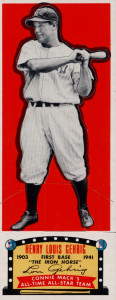
Even today, Gehrig’s enduring courage in the face of mortality resonates with Americans. He’s one of the few pre-war baseball players whose name is still iconic in today’s world (along with Babe Ruth, Ty Cobb and Cy Young).
Since 1955, the Lou Gehrig Memorial Award has been give each year to the player who exhibits the character and integrity of Lou Gehrig.
The ALS Association’s Greater New York Chapter holds an annual fundraising dinner named the Lou Gehrig Sports Awards Benefit. For more information on Amyotrophic Lateral Sclerosis or if you would like to donate to the fight against ALS, please visit the ALSNY website.
If you have any Lou Gehrig baseball cards (produced between 1925 and 1967) to sell or any items on our baseball buy list, PLEASE CONTACT Mark Rubin at 914-725-2225 or via email at mark@amerlegends.com. A quick phone call is all it takes to get started.
